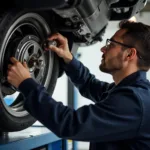Car mechanic simulator repair suspension challenges are a great way to hone your virtual wrenching skills. Whether you’re a seasoned grease monkey or just starting out, understanding the ins and outs of suspension repair is crucial for a smooth and safe ride in the digital world and the real one.
This article will guide you through the intricacies of suspension repair in car mechanic simulators, providing you with the knowledge and confidence to tackle any suspension job that comes your way.
Understanding Suspension Systems in Car Mechanic Simulators
Before you dive into the nuts and bolts (literally!), it’s important to understand what the suspension system does and its key components.
In simple terms, the suspension system is responsible for keeping your car’s tires in contact with the road, absorbing bumps and dips, and ensuring a comfortable ride.
Here’s a breakdown of the typical components you’ll encounter in a car mechanic simulator:
- Springs: These absorb shocks from bumps and dips in the road, keeping the car from bouncing excessively.
- Shocks/Struts: These dampen the spring’s movement, preventing the car from oscillating uncontrollably.
- Control Arms: These connect the wheels to the frame and allow them to move up and down while maintaining proper alignment.
- Bushings: These rubber components isolate and reduce noise and vibration between metal parts.
- Sway Bars (Anti-Roll Bars): These limit body roll during cornering, improving handling and stability.
Common Suspension Problems You’ll Face in Simulators
Car mechanic simulators often throw a variety of suspension issues your way, mimicking real-world problems. Recognizing these issues is the first step to a successful repair.
Here are some common suspension problems to watch out for:
- Worn Shocks or Struts: Symptoms include a bouncy ride, excessive nosediving during braking, and uneven tire wear.
- Damaged Springs: A broken spring can cause a noticeable drop in ride height, a clunking noise, and poor handling.
- Worn Control Arm Bushings: Look for squeaking noises, excessive vibration, and sloppy steering response.
- Bent or Broken Control Arms: These can result from impacts and lead to severe alignment issues and handling problems.
Repairing Suspension in Car Mechanic Simulators: A Step-by-Step Guide
Now that you understand the basics, let’s get our hands dirty with a typical suspension repair job in a car mechanic simulator.
For this example, we’ll walk through replacing worn-out shock absorbers:
- Raise the Vehicle: Use the simulator’s lift to safely raise the car and secure it for work.
- Remove the Wheel: This will give you access to the shock absorber.
- Detach the Shock Absorber: Locate the top and bottom mounting bolts of the shock absorber. Use the appropriate wrenches or tools in your simulator’s inventory to loosen and remove them.
- Install the New Shock Absorber: Align the new shock absorber with the mounting points and secure it using the bolts you removed earlier.
- Reinstall the Wheel: Put the wheel back on and tighten the lug nuts to the manufacturer’s specifications (information usually found within the simulator).
- Lower the Vehicle: Carefully lower the vehicle from the lift.
- Test Drive: Take the car for a spin in the simulator to ensure the repair was successful and the ride quality has improved.
Remember, different car mechanic simulators might have slight variations in their interfaces and procedures. Always consult the game’s manual or tutorials for specific instructions.
Tips for Success in Car Mechanic Simulator Suspension Repair
Here are some additional tips to excel in your virtual suspension repairs:
- Utilize the Tutorial: Most car mechanic simulators offer in-depth tutorials. Take advantage of these to familiarize yourself with the game’s mechanics and tools.
- Pay Attention to Details: Just like in real-life repairs, accuracy is key. Make sure you’re using the correct tools and following the proper steps.
- Don’t Be Afraid to Experiment: Simulators offer a risk-free environment to learn. Try different approaches, experiment with various tools, and learn from your mistakes.
Taking Your Skills Beyond the Simulator
While car mechanic simulators provide an excellent platform to learn and practice, remember that real-world repairs require professional guidance and hands-on experience.
These simulators can be incredibly realistic; they shouldn’t replace proper training and safety precautions when working on a real vehicle.
Conclusion
Mastering car mechanic simulator repair suspension tasks can be a rewarding experience. By understanding the fundamentals, recognizing common issues, and following the correct procedures, you can become a virtual suspension guru in no time!
Now that you’re equipped with this knowledge, dive back into your favorite car mechanic simulator and tackle those suspension repairs with confidence.


